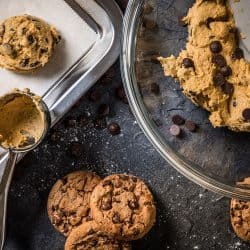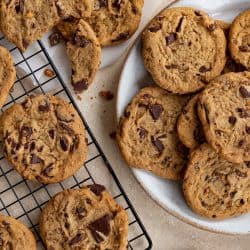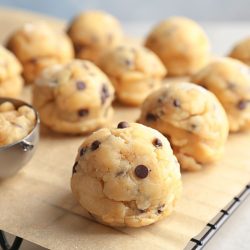Are you craving homemade cookies but realized you don't have any butter? No problem! Or maybe you're looking to make a sweet treat with a healthier ingredient list. You may even be cooking without butter to avoid dairy. No matter your reason, you're in luck because are many different ways to make cookies without butter.
You can make cookies without butter by using a substitute ingredient. Items like cooking oils, non-dairy buttery spreads, and margarine, or even mashed bananas can be used instead of adding butter to make cookie dough.
In this post, we will explain the difference between butter, margarine, and spreads. We'll talk about many of the suitable substitutes for butter with corresponding recipes, and we'll also touch on other resources that will be helpful in your future baking endeavors. Now, let's learn more about how to bake cookies without butter.

Why Make Cookies Without Butter?
You can make cookies without butter for a number of reasons. You could be out of butter, you could be looking to cut down on your caloric or fat intake, or you could be allergic to dairy. Butterless cookies allow you to save on calories and saturated fat while experimenting with different tastes and textures. By using a substitute ingredient for butter when baking cookies, you can keep the flavor but leave behind some of the guilt.
Butter vs. Margarine vs. Buttery Spreads
Is Country Crock Butter or Margarine?
Country Crock is perhaps the most well-known buttery spread brand on the market. While the company does sell one product that includes real butter, typical Country Crock is a non-dairy product that serves as a buttery-like spread comprised of a vegetable oil blend.
Can You Substitute Butter with Oil?
Another common butter replacement for baking is cooking oil. Potential oil options include vegetable oil, avocado oil, coconut oil, olive oil, and canola oil.
Recipe Ideas Using Cooking Oils
- These Lemon Rosemary Olive Oil cookies from Simply Whisked will have your tastebuds singing.
- This easy Snickerdoodle recipe from The Frugal South that calls for vegetable oil in place of butter will have you forgetting that butter even existed.
- These Butterless Chocolate Chip Cookies from Life As A Strawberry that use coconut oil in lieu of butter have over 128 five-star ratings on Pinterest.
What Oil Is Best for Baking Cookies?
Oil works well in cookies in place of butter because it binds the ingredients, much like butter would. But if so many oils work, how do you decide which one to use? Different oils will work better with certain types of cookies. Some oils will affect taste and texture; others will not.
For example, olive oil adds a richness to cookies that butter does not. Coconut oil is a healthier option that provides a simple sweetness that is noticeable but not overpowering, while canola oil is probably the most neutral oil and will not be detected in the slightest.
How to substitute oil for Butter in a Cookie Recipe
When substituting oil for butter, a good rule of thumb is to use half the amount of oil as what is called for in butter. For example, if your recipe calls for 1-cup of butter, use 1/2-cup of oil. If you find that this leaves your dough too glossy or greasy, add a little more flour into the dough.
The good thing about baking cookies with oil is that most cooking oils are interchangeable. A recipe that calls for vegetable oil can easily be made with another cooking oil such as canola oil. All of this is to taste and very much a personal preference.
When subbing a cooking oil for butter in a cookie recipe, there's no need to also spray your pan before baking. The oil in the cookie with help create a non-stick barrier but using a product like a non-stick baking mat will also ensure that your cookies are crisp on the bottom without sticking to the pan. Click here to see a silicone baking mat on Amazon.
Can you use half oil and half butter in cookies?
Maybe you want to cut back slightly on the amount of fat you bake with, but you're not ready to part with the flavor completely. If that's you, rest assured. You can definitely bake cookies using butter and oil. This sugar cookie recipe is a perfect example as it calls for both coconut oil and butter.
Healthy, Non-Oil Butter Substitutes
Other suitable substitutes for butter that are easier on your waistline include unsweetened applesauce, mashed bananas, nut butter, and even greek yogurt. The method of substitution varies by which ingredient you plan to use.
- How to substitute with applesauce: If a recipe calls for 1-cup of butter, use 1/2-cup of unsweetened applesauce. This swap works best in sugar cookie recipes.
- How to substitute with bananas: Mash bananas and use half the amount of called for butter. You can add more if your batter is too dry. Start small and add more until desired batter consistency is achieved.
- How to substitute with greek yogurt: Use half of the amount of called for butter. Using greek yogurt will add a level of texture and creaminess that butter won't, not to mention higher protein levels. These soft and puffy greek yogurt cookies, complete with frosting recipe, are reminiscent of the colorful chewy frosted sugar cookies from your local grocery store, minus the guilt.
What Is A Good Non-Dairy Substitute for Butter?
Margarine or buttery spreads are the most common substitute for butter in baking. Neither contains dairy, and both work well because they offer a similar taste and texture. A few well-known brands that sell non-dairy butter products are I Can't Believe It's Not Butter, Country Crock, Earth's Balance, and Smart Balance. Most of which can be found at your local grocery store.
Which butter substitute is the best?
Now that you know that you can bake cookies with a number of different ingredients in place of butter, you may be asking yourself how each of these will affect the cookie. The texture, flavor, and even the color of a cookie can differ depending on which fat or butter substitute you use.
Other helpful cookie baking tips
Your ingredients aren't the only important thing to consider while baking. Make sure you are using the right tools to achieve perfect cookies each time. Start with a cookie scoop to prepare uniformly sized cookies. Click here to see OXO scoop on Amazon.
Proper baking sheets will ensure evenly baked cookies. Click here to see Nordic Ware baking sheets on Amazon.
Cooling racks will help you cook cookies quickly so they stay crisp. Click here to see Checkered Chef cooling racks on Amazon.
Each of these products has received rave reviews on Amazon and will help make your baking experience easier.
Bake Butter-free Cookies and Enjoy!
So whether you don't have butter on hand, you're dealing with a dairy intolerance, or maybe you just want to cut out on some fat, you can still enjoy delicious cookies. The convenient part about swapping butter for another ingredient is that your options for subs are plentiful. You probably have some of these options in your pantry already, which makes the decision to bake cookies without butter an easy one.
For more great baking tips, check out our related articles:
Should You Melt Butter When Making Cookies And Cake?
Do Cookie Jars Keep Cookies Fresh? [Inc. special tips]







![Chocolate cookies in a glass jars, Do Cookie Jars Keep Cookies Fresh? [Inc. special tips]](https://kitchenseer.com/wp-content/uploads/2020/08/Chocolate-cookies-in-a-glass-jar-250x250.jpg)


